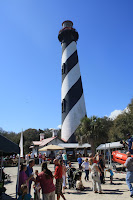Enlightening at the Lighthouse
 On the first day of Spring, the 18th annual St. Augustine Lighthouse Festival rocked Anastasia Island. With the event rounding out the Maritime Conference hosted by the Lighthouse Archaeological Maritime Program (LAMP), this year's event was bigger, better, and more maritime than ever. Many different organizations and groups turned out for the festival, including the Coast Guard, the St. Augustine Archaeological Association, and the staff from the GTM Research Reserve (located near Ponte Vedra).
On the first day of Spring, the 18th annual St. Augustine Lighthouse Festival rocked Anastasia Island. With the event rounding out the Maritime Conference hosted by the Lighthouse Archaeological Maritime Program (LAMP), this year's event was bigger, better, and more maritime than ever. Many different organizations and groups turned out for the festival, including the Coast Guard, the St. Augustine Archaeological Association, and the staff from the GTM Research Reserve (located near Ponte Vedra). New to the festival this year was a wooden boat show which invited hobbyists to come and display their wooden water crafts. In addition, the public was invited to walk around the historic grounds and climb the lighthouse, free of charge.
New to the festival this year was a wooden boat show which invited hobbyists to come and display their wooden water crafts. In addition, the public was invited to walk around the historic grounds and climb the lighthouse, free of charge.Under clear spring skies, the FPAN interns handed out this year's Florida
 Archaeology Month poster in addition to having an "Anchor Mapping" activity. This activity challenged the would-be maritime archaeologist to map out an anchor and heavy chain through using a grid system, similar to the way archaeologists do when "in the field." By using this system, archaeologists attempt to get a more accurate drawing of the features and artifacts that are found in various bodies of water (be it lake, ocean, river, etc). These drawing are key for projects where under-water photography or videography are unlikely to be successful.
Archaeology Month poster in addition to having an "Anchor Mapping" activity. This activity challenged the would-be maritime archaeologist to map out an anchor and heavy chain through using a grid system, similar to the way archaeologists do when "in the field." By using this system, archaeologists attempt to get a more accurate drawing of the features and artifacts that are found in various bodies of water (be it lake, ocean, river, etc). These drawing are key for projects where under-water photography or videography are unlikely to be successful.Until next time Mateys!
--Rosalie